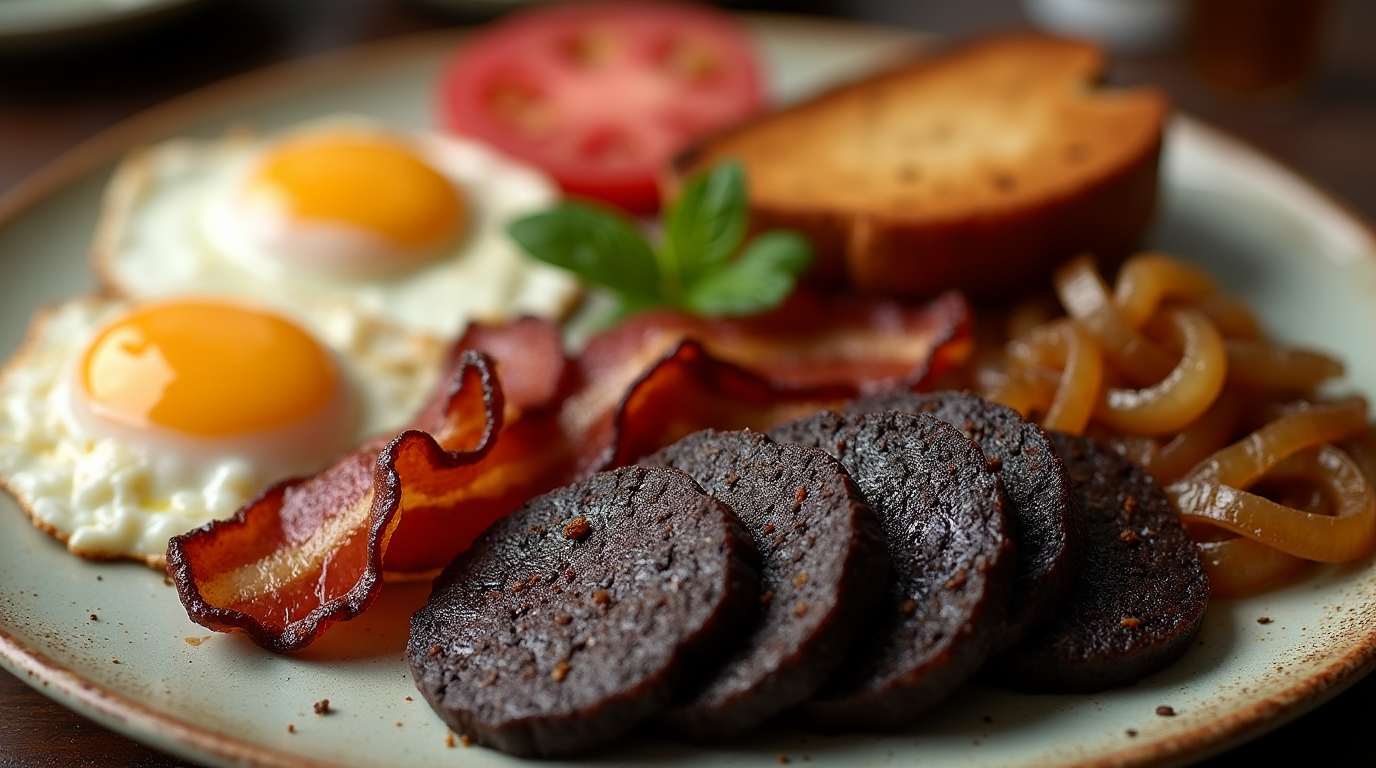Black Pudding (Ireland): From Farm to Table
When you hear the term “black pudding,” you might think of an old-fashioned breakfast dish, a food that is steeped in tradition and perhaps a bit unusual for those unfamiliar with it. But black pudding is so much more than that. Whether you’ve grown up enjoying it as part of a hearty English breakfast or you’re just curious about this unique dish, you’ll find that black pudding is a versatile, flavorful, and surprisingly nutritious food that deserves a place in your kitchen.
In this article, we’ll dive deep into what black pudding is, its health benefits, and how to prepare it at home. Plus, we’ll share some delicious recipes and tips on where to find the best black pudding. So, let’s explore the rich history and savory delights of this beloved dish.
What Is Black Pudding? A Delicious Introduction
Black pudding, often called blood sausage, is a traditional dish made from animal blood, typically pig’s blood, mixed with a variety of ingredients like oats, barley, fat, and spices. It’s then encased in natural casings, which are usually pig intestines, before being cooked.
Historical Background
Black pudding has a long history that dates back centuries. It’s a beloved food in the UK, Ireland, and parts of Europe, with variations found in Spain (known as morcilla), France (as boudin noir), and beyond. In the UK and Ireland, black pudding is commonly served as part of a traditional breakfast, alongside eggs, sausages, and beans. In some cultures, it’s considered a delicacy that’s enjoyed in various forms, from soups and stews to croquettes and salads.
Flavor Profile
Black pudding offers a rich, earthy, and savory flavor. Its combination of blood and grains gives it a unique texture, while the spices used during preparation—such as black pepper, allspice, and cinnamon—add depth to the taste. It’s an acquired taste for some, but once you experience it, black pudding is a deliciously satisfying food.
The Surprising Health Benefits of Black Pudding
You might be surprised to learn that black pudding isn’t just a flavorful treat; it’s also packed with essential nutrients. Here are a few reasons why you might want to consider adding black pudding to your diet:
1. Rich in Iron
Black pudding is an excellent source of heme iron, the type of iron found in animal products. This form of iron is more easily absorbed by your body compared to the non-heme iron found in plant-based foods. Including black pudding in your meals can help prevent iron deficiency, which can lead to fatigue and weakness.
2. High in Protein
With its combination of blood, oats, and fat, black pudding is a great source of protein. Protein is essential for muscle repair, immune function, and overall body maintenance. It’s particularly beneficial for those who follow a high-protein diet or are looking to add variety to their meals.
3. Packed with B Vitamins
Black pudding is rich in B vitamins, particularly B12, which plays a vital role in brain health, energy production, and the formation of red blood cells. B12 deficiency can cause fatigue, weakness, and neurological issues, so including black pudding in your diet can help support your overall well-being.
4. Mineral-Rich
In addition to iron and B vitamins, black pudding contains a variety of other minerals, including zinc, selenium, and phosphorus. These minerals are crucial for maintaining a healthy immune system, strong bones, and good cellular function.
5. Considerations
While black pudding offers numerous health benefits, it’s also high in fat and sodium, so it’s important to consume it in moderation. If you’re watching your cholesterol or sodium intake, be mindful of your portion sizes.
How to Make Black Pudding at Home: A Simple Recipe

If you’ve always wanted to try making black pudding from scratch, the process isn’t as difficult as you might think. Here’s a basic recipe to get you started:
Recipe Ingredients
| Ingredients | Amount |
|---|---|
| Pig’s blood (or beef) | 500 ml |
| Oats or barley | 300 g |
| Suet (animal fat) | 100 g |
| Onion (chopped) | 1 medium |
| Salt and pepper | To taste |
| Ground spices (e.g., cinnamon, allspice) | 1-2 tsp |
| Pig’s intestines (or sausage casings) | As needed |
Cooking Instructions
- Cook the Grains: In a large pot, cook the oats or barley according to package instructions until they are tender.
- Prepare the Blood: While the grains are cooking, heat the pig’s blood in a separate pan over low heat, being careful not to let it boil. Stir occasionally to prevent clumping.
- Mix the Ingredients: In a large bowl, combine the cooked grains, suet, chopped onion, salt, pepper, and spices. Gradually add the blood, mixing until you have a thick, smooth consistency.
- Stuff the Casings: Carefully stuff the mixture into the sausage casings. Tie the ends securely and make sure the sausages are well-packed.
- Cook the Black Pudding: Place the stuffed casings into a large pot of boiling water and cook for 30-40 minutes, or until firm to the touch.
- Chill and Serve: Allow the black pudding to cool completely before slicing and serving.
Black Pudding Recipes: Delicious Dishes to Try
Black pudding isn’t just for breakfast; it can be used in a variety of dishes to add flavor and richness. Here are some creative ways to enjoy it:
1. Black Pudding Breakfast Bowl
A classic way to enjoy black pudding is as part of a full breakfast. For a twist, try serving it with scrambled eggs, grilled tomatoes, and avocado for a balanced and delicious breakfast bowl.
2. Black Pudding and Potato Hash
This hearty dish is perfect for brunch or dinner. Combine sautéed black pudding with crispy potatoes, caramelized onions, and a touch of paprika for a comforting and filling meal.
3. Black Pudding Croquettes
For a tasty snack or appetizer, try making black pudding croquettes. Coat slices of black pudding in breadcrumbs and fry until crispy. Serve with a tangy dipping sauce for extra flavor.
4. Black Pudding Salad
For a lighter meal, toss black pudding with mixed greens, roasted beets, and a tangy vinaigrette. The earthy flavors of the black pudding pair beautifully with the sweetness of the beets.
5. Black Pudding Frittata
This simple one-pan meal combines black pudding with eggs, cheese, and sautéed spinach. It’s perfect for a quick weeknight dinner or a satisfying brunch.
Where to Buy Black Pudding: Tips for Finding Quality Products
Finding high-quality black pudding is essential for getting the best flavor and texture. Here are some tips for sourcing it:
1. Look for Local Artisanal Black Pudding
If you live in the UK or Ireland, try visiting your local butcher or farmer’s market for freshly made black pudding. Artisanal producers often use higher-quality ingredients and traditional methods for the best taste.
2. Online Retailers
Many online retailers specialize in gourmet foods, including black pudding. You can find a variety of options, from traditional to modern, and even vegetarian versions.
3. Check for Quality Indicators
When purchasing black pudding, look for options that are free from preservatives and artificial additives. The best black pudding should have a natural casing and a balanced mix of blood, grains, and spices.
Is Black Pudding Safe to Eat? Common Concerns
While black pudding is generally safe to eat, there are some important considerations:
1. Cooking
It’s crucial to cook black pudding thoroughly, as it contains blood, which must be properly prepared. As long as it’s cooked according to the recipe instructions, it’s perfectly safe to eat.
2. Dietary Restrictions
Black pudding is not suitable for vegetarians or those with certain dietary restrictions due to its animal-based ingredients. If you have high blood pressure or are watching your sodium intake, it’s best to enjoy black pudding in moderation.
FAQ Section
What is black pudding made from?
Black pudding is made from pig’s blood, oats, fat, onions, and spices. It’s then stuffed into sausage casings and cooked until firm.
Is black pudding healthy?
Yes, black pudding is a great source of protein, iron, and B vitamins. However, it’s also high in fat and sodium, so it should be eaten in moderation.
Can black pudding be cooked in different ways?
Yes! Black pudding can be grilled, fried, or added to stews and soups. It’s versatile and adds flavor to many dishes.
Where can I buy black pudding?
Black pudding can be found in many supermarkets in the UK and Ireland, as well as specialized butchers. It’s also available online from various retailers.
Conclusion
Black pudding may be an acquired taste, but once you give it a try, you’ll discover a rich and versatile food that’s as nutritious as it is delicious. From its historic roots to its impressive health benefits, black pudding is more than just a breakfast food—it’s a culinary tradition worth exploring. So, whether you’re making it at home or picking up a package from your local market, give black pudding a try and see how it can elevate your meals. Happy cooking!

